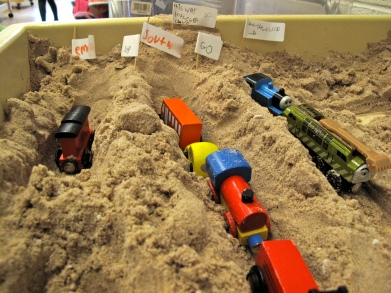How important is sensory play?
Stimulating the senses sends signals to children’s brains that help to strengthen neural pathways important for all types of learning. For example, as children explore sensory materials, they develop their sense of touch, which lays the foundation for learning other skills, such as identifying objects by touch, and using fine-motor muscles. The materials children work with at the sand and water table have many sensory attributes — they may be warm or cool, wet or dry, rough or smooth, hard or soft, textured or slimy. Discovering and differentiating these characteristics is a first step in classification, or sorting — an important part of preschoolers’ science learning and discovery – Gainsley, 2011).
In our own classroom context, we have often grappled with the ‘discomfort’ of the sand and water tables. Located beside each other in our own classrooms, a child cannot help but blend the two together on a regular basis. In time, we recognized that we were spending significant amounts of time policing this area and talking more about the ‘do-not’s’ than the ‘do’s.’ After much frustration and conversation among teachers, we decided that we would let happen what was destined to happen anyway: The sand would become a part of the water table, and the water would become a part of the sand table.
What ensued was rich, sensory learning. Safaris, lakes, deserts, lemonade stands, and much, much more. What benefits were there to allowing children the control to follow their sensory interests?
The article entitled: “Look, Listen, Touch, Feel, Taste: The Importance of Sensory Play,” by Suzanne Gainsley (2011) highlights the very importance of these opportunities. However, teachers can come up with many reasons for why the sand and water tables may remain ‘closed’ in the early years classroom…
There isn’t enough room for art projects or a sand and water table.
It’s too messy.
The sand and water table (or art area) is just a boring and empty space.
(Gainsley, 2011).
Sometimes, new provocations placed in these tables can inspire rich and interesting thinking. To see the article and to gain new insight about the importance of sensory play and ideas for your own sand and water tables, visit:


